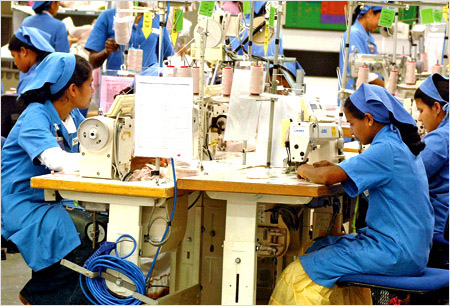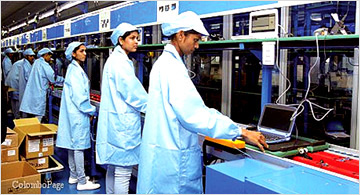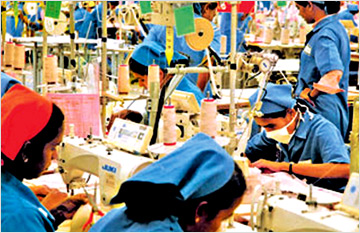|
Foreign remittances record US $ 6.4 billion in 2013:
Foreign Direct Investment inflows Increased to US $
1.4 billion in 2013:
Economy reaching dizzy heights
7.8 percent GDP growth:
Upward trend in exports:
By Sanjeevi Jayasuriya

Sri Lanka has
progressed well in the economic front with many sectors performing at
extremely satisfactory level. All indicators lead towards a prosperous
nation.
|
The positive
reserve scenario is supported by the growth in the revenue from
the export of goods estimated at US $ 12 billion for 2014 as
opposed to US $ 10.4 billion in 2013. The increased contribution
primarily coming from the export of high-value apparel products
and a shift in tea exports to value-added branded products. |
The country is expected to have a GDP growth of 7.8 percent for 2014
following a 7.3 percent GDP growth in 2013 supported by favourable
performance in sectors of exports, tourism, construction and IT
services.
The economy is on an upward trend since the dip in 2012 though not as
bullish as the first two years immediately after war.
Keeping up with the target of transitioning to a middle income
country, Sri Lanka achieved per capita income of US $ 3,719 for 2014.
However, the World Bank's Global Economic Prospects report issued in
June 2014 forecast Sri Lanka's economic growth to remain broadly stable
at 7.2 percent in 2014 and forecasts the GDP growth rate to moderate
about 6.9 percent in 2015 and 6.7 percent in 2016.
 These projections position Sri Lanka as the fastest growing South
Asian nation, ahead of the regional average of 5.3 percent, 5.9 percent
and 6.7 percent for 2014, 2015 and 2016 respectively. These projections position Sri Lanka as the fastest growing South
Asian nation, ahead of the regional average of 5.3 percent, 5.9 percent
and 6.7 percent for 2014, 2015 and 2016 respectively.
The economy is dominated by the services sector, with key drivers in
this sector been wholesale and retail trade, transport and communication
and banking, insurance and real estate contributing significantly during
the last five years to the economic growth in the country.
Manufacturing and construction segments within the industry sector
have also contributed significantly to the recent economic growth.
Collectively the wholesale and retail, transport, communication,
manufacturing and construction sub segments account for over 60 percent
of the growth.
The Government has identified SMEs as key to sustainable economic
growth.
The Government's policy framework for economic development has
identified micro, small and medium-sized enterprises, traditional
industries and the handicraft industry as strategic sectors. It is the
intention of the government to provide policy support to those sectors
that can effectively create new capacity and to channel development
assistance that will lead to expansion and growth of the economy.
It is estimated that SMEs accounted for 80 - 90 percent of the total
number of enterprises. Leading SME industries include agriculture,
plantation, construction, manufacturing, trade and services.
The SMEs contributed to 30 percent of the GDP (gross domestic
production), 20 percent of exports, employed 30 percent of the total
workforce.
It is important to note that net exports and investments were drivers
of GDP growth in 2013 and these are continuing to drive the economic
growth in 2014 as well.
In 2013 net exports and investments increased by 20 percent and 10
percent respectively over 2012.
Private sector credit growth has declined over the past year despite
decreasing interest rates. Private sector credit grew 24 percent, 36
percent and 21 percent during 2010 - 2012 respectively. Consumption
growth contributed significantly to this growth, driven by gold based
borrowing.
 The rapid credit growth forced the Central Bank of Sri Lanka to
intervene by increasing interest rates and imposing a credit growth
ceiling in mid-2012. Rising rates coincided with collapse in gold prices
caused significant amount of non-performing loans and a freeze in the
pawning loans. This seems to be a significant reason for deceleration in
the private sector credit growth resulting in lower overall private
sector credit growth of 7.7 percent during 2013. The rapid credit growth forced the Central Bank of Sri Lanka to
intervene by increasing interest rates and imposing a credit growth
ceiling in mid-2012. Rising rates coincided with collapse in gold prices
caused significant amount of non-performing loans and a freeze in the
pawning loans. This seems to be a significant reason for deceleration in
the private sector credit growth resulting in lower overall private
sector credit growth of 7.7 percent during 2013.
Easing of monitory policy in 2013 and the decline in inflation have
enabled a declining trend in interest rates. However, the decline in
lending rates has not been so pronounced. Banks and NBFIs have been
protecting their margins at the expense of loan growth. Partly due to
this lag effect, despite the policy rate decline, indicators reveal that
credit growth has yet to pick-up significantly in 2014.
Decline of borrowing of state owned business enterprises from the
banking system and some larger companies which are over-leveraged have
started to reduce their debt exposure. These could limit overall credit
growth as well.
Sri Lanka's private sector credit as a percentage of the GDP is
relatively low at an average of 30 percent over the past three years.
The projected increase in per capita income should lead to an increase
in personal consumption and provide an opportunity for increased
personal lending.
The CBSL is confident of maintaining inflation at mid-single digit
levels with single digit interest rates in to the foreseeable future.
Inflation remained at single digit levels for the fifth consecutive year
despite supply disruption due to adverse weather conditions and fuel
price increases.
Considering the lower demand for credit and excess liquidity in the
market the low interest rates are expected to continue in the short run
until the private sector investments and demand for credit increases.
Foreign Direct Investment inflows increased to US $ 1.4 billion in
2013, of which infrastructure and manufacturing sectors attracted the
highest FDI inflows in 2013. The share of FDIs inflows in to
infrastructure amounted to 56.5 percent of total FDIs with major
investments in telephone and telecommunication networks, housing and
property development and ports and container terminals. Increasing FDI
inflows is critical to boost the confidence in the Sri Lankan economy
and to fuel economic growth.
Foreign remittances rose over 50 percent from 2010 levels to US $ 6.4
billion in 2013.
This is attributed to an increase in more skilled and semi-skilled
Sri Lankans being employed abroad.
The CBSL projects foreign remittances increasing to US $ 7 billion by
2014 and US $ 8.3 billion by 2016.
These increased foreign inflows supported by foreign borrowings have
resulted in gross official reserves of the country reaching above US $ 8
billion.
Though this is a healthy reserves scenario as compared with the past,
in comparison to emerging economies still lies in the lower end.
Given these reserves consist of debt inflows it carries the risk of
flowing out as a result of change in external conditions which can
contribute to Sri Lanka rupee exchange rate depreciation.
The positive reserve scenario is supported by the growth in the
revenue from the export of goods estimated at US $ 12 billion for 2014
as opposed to US $ 10.4 billion in 2013. The increased contribution
primarily coming from the export of high-value apparel products and a
shift in tea exports to value-added branded products.
Revenue from the export of services also increased in 2014, with
significant contributions from port and airport related services,
tourism services, export of IT/BPO services and knowledge economy
services.
The country is moving towards a knowledge economy as directed in the
Mahinda Chintana policy document with an enabling environment where
systematic planning and consistent policies play a key role in this
regard. |

